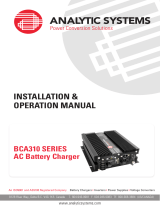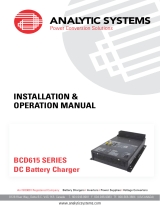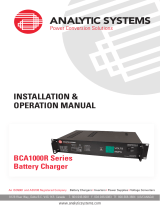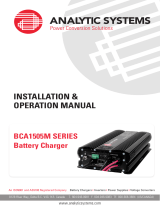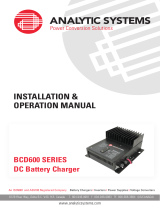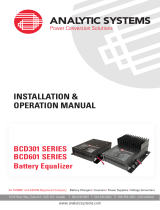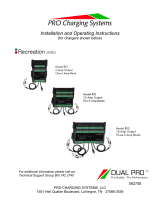Page is loading ...

INSTALLATION &
OPERATION MANUAL
BCA1000
AC Source
Battery Charger
8128 River Way, Delta B.C. V4G 1K5 Canada T. 604.946.9981 F. 604.946.9983 TF. 800.668.3884 (US/CANADA)
www.analyticsystems.com
An ISO9001 and AS9100 Registered Company Battery Chargers • Inverters • Power Supplies • Voltage Converters

Copyright (2005-2016) Analytic Systems Ware (1993) Ltd.
Revised - May 18, 2016

3
IMPORTANT & SAFETY INSTRUCTIONS
1. SAVE THESE INSTRUCTIONS — This manual contains important safety and operating
instructions for battery charger
2. Do not expose battery charger to rain or snow.
3. Use of an attachment not recommended or sold by the battery charger manufacturer may
result in a risk of re, electric shock, or injury to persons.
4. Do not disassemble battery charger; take it to a qualied serviceman when service or
repair is required. Incorrect reassembly may result in a risk of electric shock or re.
5. To reduce risk of electric shock, unplug battery charger from outlet before attempting any
maintenance or cleaning. Turning off controls will not reduce this risk.
6. Never place battery charger directly above battery; gases from battery will corrode and
damage battery charger.
7. Never allow battery acid to drip on battery charger when reading gravity or lling battery.
8. O/P CONNECTION PRECAUTIONS
Connect and disconnect DC output connections only after setting the I/P power switch to
the off position.
ALL BATTERY CHARGERS
1. WARNING — RISK OF EXPLOSIVE GASES.
i. WORKING IN VICINITY OF A LEAD-ACID BATTERY IS DANGEROUS. BATTERIES
GENERATE EXPLOSIVE GASES DURING NORMAL BATTERY OPERATION. FOR THIS
REASON, IT IS OF UTMOST IMPORTANCE THAT EACH TIME BEFORE SERVICING
EQUIPMENT IN THE VICINITY OF THE BATTERY, YOU READ THIS MANUAL AND
FOLLOW THE INSTRUCTIONS EXACTLY.
ii. To reduce risk of battery explosion, follow these instructions and those published
by battery manufacturer and manufacturer of any equipment you intend to use in
vicinity of battery. Review cautionary marking on these products and on engine.
2. PERSONAL PRECAUTIONS
i. Someone should be within range of your voice or close enough to come to your aid
when you work near a lead-acid battery.
ii. Have plenty of fresh water and soap nearby in case battery acid contacts skin,
clothing, or eyes.
iii. Wear complete eye protection and clothing protection. Avoid touching eyes while
working near battery.
iv. If battery acid contacts skin or clothing, wash immediately with soap and water.
If acid enters eye, immediately ood eye with running cold water for at least 10
minutes and get medical attention immediately.

4
v. NEVER smoke or allow a spark or ame in vicinity of battery or engine.
vi. Be extra cautious to reduce risk of dropping a metal tool onto battery. It might spark
or short-circuit battery or other electrical part that may cause explosion.
vii. Remove personal metal items such as rings, bracelets, necklaces, and watches
when working with a lead-acid battery. A lead-acid battery can produce a short-
circuit current high enough to weld a ring or the like to metal, causing a severe burn.
viii. NEVER charge a frozen battery.
ix. If necessary to remove battery from service, always remove grounded terminal from
battery rst. Make sure all accessories in the vessels are off, so as not to cause an
arc.
x. Be sure area around battery is well ventilated.
xi. Clean battery terminals. Be careful to keep corrosion from coming in contact with
eyes.
xii. Study all battery manufacturer’s specic precautions such as removing or not
removing cell caps while charging and recommended rates of charge.
xiii. Add distilled water in each cell until battery acid reaches level specied by battery
manufacturer. This helps purge excessive gas from cells. Do not overll. For a
battery without cell caps, carefully follow manufacturer’s recharging instructions.
GROUNDING AND AC POWER CORD CONNECTION INSTRUCTIONS
The plug must be plugged into an outlet that is properly installed and grounded in accordance
with al local codes and ordinances.
DANGER Never alter AC cord or plug provided — if it will not t outlet, have proper cord
installed by a qualied electrician. Improper connection can result in a risk of an electric
shock.
Analytic Systems does not recommend the use of the BCA1000 Series Battery Chargers in life
support applications where failure or malfunction of this product can be reasonably expected
to cause failure of the life support device or to signicantly affect its safety or effectiveness.
Analytic Systems does not recommend the use of any of its products in direct patient care.
Examples of devices considered to be life support devices are neonatal oxygen analyzers,
nerve stimulators (whether used for anesthesia, pain relief, or other purposes), autotransfusion
devices, blood pumps, debrillators, arrhythmia detectors and alarms, pacemakers,
hemodialysis systems, peritoneal dialysis systems, neonatal ventilator incubators, ventilators
for both adults and infants, anesthesia ventilators, and infusion pumps as well as any other
devices designated as “critical” by the U.S. FDA.

5
Introduction
All new Current Mode switching design offers increased power and reliability in a compact
package. Extra input and output ltering reduce EMI to extremely low levels. Reliability
features include an input fuse, thermal shutdown, current limiting, reverse battery hookup
protection and output short circuit shutdown with automatic recovery. The output voltage
is easily adjusted 1.0 volts above or below the standard output voltage. The model
BCA1000 Battery Charger supplies either 12, 24, 32 or 48 VDC from a 110 or 220 VAC power
source. High quality digital meters can be added (factory option) to allow monitoring of
charging current and charging voltage. A remote control option or equalize & temperature
compensation (factory installed) option is available for this model.
Features
In a DC UPS ( Un-interruptible Power Supply ), the charger simultaneously powers the DC load
as well as the battery. As long as the AC power to the charger is available and the charger is
working normally, the charger will supply the DC load as well as charge / oat the battery. In
case the AC power fails or if the charger stops working, the battery will automatically power
the DC load. As soon as the AC power to the charger is restored, the DC load will once again
be fed by the charger and at the same time the battery will be recharged. CAUTION! Please
ensure that the sum of the current drawn by the DC load and the current desired for charging
the battery is less than the maximum current capacity of the charger. To use as a DC UPS, rst
switch off the DC load and connect it to the battery. Now connect the battery. Switch on the
charger and then switch on the DC load.
Specications
Input Voltages
Nominal (ip) 110 220
Actual (Vac) 90 – 130 180 - 260
Frequency (Hz) 45 - 65
Input Amps (max) 17 8.5
Input Fuse (Slow Blow) MDA-20 (12V) / MDA-25 all others MDA-10 (12V) / MDA-15 all others
Output Voltages
Nominal (op) 12 24 32 48
Float (Vdc) 13.6 ± 0.05 27.2 ± 0.05 36.3 ± 0.05 54.4 ± 0.05
Absorption Voltage (Vdc) 14.4 28.8 38.4 57.6
Charging Amps 60 40 30 20
Absorption to Float 9 Amps 6 Amps 4.5 Amps 3 Amps
Output Fuses (ATC) 40 x 2 40 x 2 40 x 2 25 x 2
Battery Banks 1 or 2 1 or 2 1 or 2 1 or 2
Output Adjust ± 1.0 Volts

6
Designed and manufactured by: ANALYTIC SYSTEMS WARE (1993) LTD.
8128 River Way, Delta, BC V4G 1K5
Canada
p. 604.946.9981 f. 604.946.9983 tf. 800.668.3884 US/Canada
www.analyticsystems.com [email protected]
* This is Analytic Systems’ suggested range. Please consult your battery manufacturer for their
recommendations.
* Specications subjects to change without notice.
Battery Size (Amp Hours)* 240 – 360 160 – 240 120 – 180 80 - 120
Output Crowbar 16.0 ± 0.5 V 32 ± 1.0 V 42.7 ± 1.3 V 63.9 ± 2.0 V
Equalize Voltage (Vdc) 15.5 31 41.3 62
Temperature Compensation Coefcient -30mV /
o
C -60mV /
o
C -80mV /
o
C -120mV /
o
C
General
Stages 2 or 3
Noise on Input < 50 milli-volts
Noise on Output < 50 milli-volts
Transient Resp. < 2V for 10A Surge
Efciency > 75 % @ maximum output
Temp. Range -25 to +40o C @ maximum output
Isolation
Input-Output & Input-Case 1500 Vdc
Output-Case 500 VDC (1500Vdc @ 48 V Out)
Length 14.5 in / 36.8 cm
Width 9.9 in / 25.1 cm
Height 5.0 in / 12.7 cm
Clearance 1 Inch (2.5 cm) all around
Material Marine Grade Aluminum
Finish Black Anodize / Black Powder Epoxy
Fastenings 18-8 Stainless
Weight 12 lb / 5.5 kg

7
Installation
MOUNTING
Mount the unit in a DRY location. Allow at least 4 inches of clearance around the heat sink
ns for adequate cooling.
POWER CONNECTION
The unit is supplied with a power cable 5 feet long. This should normally be adequate to
connect to a source of power. If you must extend the power cable be sure to use a 3 conductor
grounded type extension cable. For hard wiring to a source of power, cut off the plug, and strip
the wires as necessary. The wire colours are: to connect to a source of power. If you must
extend the power leads, be sure to use at least a good quality (typeTEW) AWG 8 gauge wire.
The wire colours are:
All connections should be made inside an appropriate junction box. The maximum current
draw from the 110 VAC supply is 13.8 amps, so a 15 amp circuit breaker should be used in the
circuit panel and for a 220 VAC supply, 6.9 amps is the maximum current draw, so a 10 amp
circuit breaker should be used in the circuit panel to feed power to the BCA1000.
OUTPUT CONNECTIONS
Two Positive output terminals and two Negative output terminals are provided. Connect only
one wire to each terminal. Ensure that the total average load connected does not exceed the
continuous current rating of the unit.
To ensure spark free connections the power switch must be in the OFF position prior to making
the connections to the battery bank(s).
The charger may be hooked to 1 or 2 battery banks. Hook up the battery bank(s) as shown
below. If you are hooking up 2 battery banks keep in mind that they MUST share a common
ground! If you are going to hook up one battery bank to the charger, you may hook up the
outputs in parallel to reduce stress on the output isolation diodes inside the charger.
110 VAC 220 VAC
Brown - AC Hot Brown - AC Hot / Phase 1
Blue - AC Neutral Blue - AC Neutral / Phase 2
Green - Ground Green/Yellow - Ground
OUTPUT 1 OUTPUT 1
OUTPUT 2 OUTPUT 2
BATTERY
BANK #1
BATTERY
BANK #1
BATTERY
BANK #2

8
Operation
Prior to turning on the unit, you must decide on which charging prole, 2 or 3 stage charging,
to use. To help you decide, please see the following section entitled 2 or 3 Stage Charging to
determine the charging prole.
Once you have decided on the charging prole you must set the switch to the correct
position. To access the switch remove the cover plate (secured by 2 screws). Set the switch
to the correct position as shown on the label. When you are done, replace the cover plate
and securely tighten the screws.
To turn the unit on, simply move the power switch to the ON position. The alarm buzzer will
sound and the Low Output LED will come on briey, and then the green OUTPUT ON LED will
illuminate.
When the unit is rst turned on, it will charge the batteries at a constant current and
the charging light will be on. After a period of time, which may be minutes to hours, the
batteries will reach the oat voltage at which time the charging light will go off, and the
charging current will reduce as necessary to maintain the batteries at that voltage. You
may check this voltage at the output terminals of the unit with a good digital voltmeter. As
shipped from the factory, the unit is preset to 13.6, 27.2, 36.3 or 54.4 VDC, which is generally
recommended for lead-acid batteries. If you wish to adjust the charging voltage, remove the
cover plate (secured by 2 screws) to expose the output adjust potentiometer. Reach in with a
very small at blade screwdriver to rotate the potentiometer. Clockwise increases the output
voltage, and counter clockwise decreases it. When you are done, replace the cover plate and
securely tighten the screws. It is advisable to check with the battery manufacturer before
changing the oat voltage.
High quality digital meters can be added to the charger (factory installed only). Both outputs
can be monitored for current and voltage
Meters

9
A two-stage charger provides a constant current until the battery reaches its rated capacity
and then switches to a “oat” voltage. The current then reduces as necessary to maintain
the battery at the oat voltage. The charger can be connected to the battery indenitely and
will provide the appropriate prole. A two-stage charger is recommended in most instances
since it is the most versatile and can be permanently connected to attenuate the characteristic
discharge of unused batteries. A load can be put on the battery or batteries without altering
its ability to keep the battery at optimal charge.
100%
75%
50%
25%
0%
Bulk
(Constant Current)
Absorption
(Constant Volts)
Maintenance
(Constant Volts)
Time
Three Stage Charger
Volts
Amps
A three-stage charger is the fastest charger. It charges the battery at a constant current
until the battery voltage reaches a slightly elevated level. The battery is maintained at
this voltage while the charging current diminishes to a low value, and then the battery is
switched to the oat voltage where it can be maintained indenitely. However, the charger
cannot differentiate between a current going to a load on the battery, or being absorbed by
the battery, so it can overcharge a battery supplying current to a load. A two-stage charger
is preferred for “loaded” batteries and a three-stage for idle or unloaded batteries during
recharging.
All of Analytic Systems’ chargers include adjustable output voltage for charging standard or
deep cycle lead-acid, VLRA or gel type batteries.
This charger features user selectable 2 or 3 stage charging. The charging prole is selected by
moving the slide switch on the front panel left to 3 stage or right for 2 stage charging.
2 or 3 Stage Charging
100%
75%
50%
25%
0%
Bulk
(Constant Current)
Maintenance
(Constant Volts)
Time
Two Stage Charger
Volts
Amps

10
Troubleshooting
This unit provides LED indicators and a buzzer to help diagnose any problems. The unit should
sound the buzzer to alert you prior to shutting itself down. You should immediately check the
indicators to determine the cause of the shutdown.
LOW OUTPUT Indicates that the output voltage is below normal because:
• The current demanded by the devices connected to the unit exceeds the maximum
output current rating, causing the output voltage to drop to maintain the current at
the maximum level
• The input voltage is not high enough for unit to operate,
LOW INPUT Indicates that the input voltage is below normal because:
• The input voltage is not in the correct range for proper operation of the unit.
OVERTEMP Indicates that the Battery Charger is running too hot because:
• Too much power is being drawn, turn off or unplug some devices.
• The Battery Charger is located in a poorly ventilated area.
• If the load exceeds the continuous rating for too long a period, the temperature
sensor inside the unit will turn off the outputs. After the unit cools sufciently, it
will automatically come back on. If this happens frequently, remount the unit for
increased airow so it cools better.
CHARGING Indicates that the battery charger is charging the batteries:
• If the LED is not on, the batteries may be fully charged and the charger is supplying a
oat voltage to the batteries to keep them fully charged.
If the load exceeds the continuous rating for too long a period, the temperature sensor inside
the unit will turn off the outputs. After the unit cools sufciently, it will automatically come
back on. If this happens frequently, remount the unit for increased airow so it cools better.
Dry Contact Relay
To use your dry contact output fail relay you must connect a 9-pin D connector to the unit.
You must use pins one and six as is indicated on page 9 in the remote connector diagram.
The relay is factory preset to fail in the closed position when the low output LED and buzzer
come on. If you wish to have the relay fail in the open position when the low output LED
and buzzer come on, you must take the cover off the unit and move the jumper to the other
position on J22. J22 is located next to the relay.

11
To change the position of the jumper, rst turn the unit off and disconnect the unit from both
the power and batteries. Next, turn the unit on for 30 seconds to discharge the capacitors,
then turn it off again. Turn the unit upside down and remove the eight screws. Remove the
cover and locate J22. It will be next to the relay as is shown in the above diagram. Simply
move the jumper to the desired position as is shown in the above diagram. Replace the cover
and re-install the eight screws. Reconnect the unit to the power and batteries.
BATTERY TEMPERATURE SENSORS
Up to 2 battery temperature sensors can be connected to the charger to allow temperature
compensation of the battery charging voltage (1 is supplied with the unit). If only the 1 sensor
is used, it MUST be plugged into the ‘BATT 1’ connection on the rear of the unit. If no sensor is
used, the charger will default to standard output voltage.
For installation instructions of the temperature sensor, please see the section entitled
Remote Battery Temperature Sensor Installation.
Remote Control Option
A remote control panel may be connected to the battery charger using a 9-pin D-connector,
which attaches to the side of the battery charger. The remote control panel and D connector
are part of the remote control option. The remote control panel allows the unit to be operated
remotely as well as duplicating all the diagnostic indicators and audible alarm.
REMOTE CONNECTOR
This connector is located on the side of the unit. Important: To prevent the possibility of High
Voltage Electrical Shock, do not power up the battery charger unless all wiring from the unit to
the remote is securely connected. Do not remove the dust cover from the DB-9 connector if the
remote is not being used.
IMPORTANT: This remote is to be used only on
Battery Chargers manufactured by Analytic Systems.

12
Equalize Option
The purpose of the Equalize Option is to deliberately overcharge the battery at a low rate of
current to ensure that all cells are fully charged and to reduce the chance of sulfation of the
battery. During the Equalize cycle, the cells, which are fully charged, will produce Hydrogen
gas, and the cells, which are undercharged, will be brought up to full charge. An Equalize
cycle should be done once every 2-3 months, or whenever battery capacity appears to be
diminished. The Equalize Option also includes a battery temperature sensor to compensate the
charging voltage for battery temperature, as well as to shut the charger down if the battery
should become overheated. A 2nd temperature sensor can be added to allow monitoring of
both batteries if the charger is connected to 2 banks of batteries.
An Equalize cycle can be initiated at any time by simply pressing the equalize start button
located next to the ON/OFF switch. This button is deliberately recessed to prevent accidental
operation. It is most easily pressed by using a ballpoint pen. If the charger is in the middle
of charging the battery (the Charging LED is on), the Equalize LED will ash. Once the main
charging cycle is complete, the Equalize cycle will begin and the Equalize LED will stay on all
the time. If the Charging LED is off when the button is pressed, the Equalize cycle will begin
immediately.
The charger will charge the battery at approximately 10% of its normal rate (i.e. 4 amps for
a 40 amp charger) until the battery reaches equalize voltage and then the current reduces as
necessary to maintain the battery at that voltage. Three hours after the Equalize cycle begins,
the charger will return to the oat mode where the battery can be maintained indenitely. If
the battery temperature reaches 120 degrees F (50 degrees C) the equalize cycle will end and
the charger output reduced to a very low voltage until the battery cools, and then the charger
will return to the oat mode.
Remote Battery Temperature Sensor Installation
The remote battery temperature sensor allows the monitoring of the battery bank so that
the charging prole can be adjusted to optimally charge the battery bank depending on the
temperature of the battery bank. NOTE: The temperature sensor must be used during an
equalize cycle or damage to the battery may occur.
The battery temperature sensor may be installed in many different ways, so long as the sensor
stays in contact with the battery. The preferred method is as follows:
The batteries to be charged will be placed on a platform made of wood. Prior to placing the
batteries on the wooden platform a cavity is hollowed out such that the sensor will t inside
the cavity and be ush with the battery. Place the sensor inside the cavity facing the proper
way (this is shown on the sensor). Next connect the sensor wiring to the telephone jack

13
marked “Batt 1” on the side of the unit. Note: If there is only one temperature sensor, it gets
plugged into “Batt 1”. If there is a second temperature sensor, it should be plugged into to the
phone jack labeled “Batt 2”.
If a battery blanket is used the sensor may be tucked inside the blanket with the proper side
of the sensor facing the battery. The sensor may be placed on top of the battery but it should
be secured to the battery so as to prevent it from losing contact with the battery.
Battery Charger Temperature Compensation
The charger is calibrated with the sensor input preset to 77 degrees (25 degrees C). For
example, for a 12V battery, this voltage is 13.6 volts, and 27.2 volts for a 24V battery. See the
specications for the temperature compensation coefcient.

14
Page intentionally left blank

15
Limited Warranty
1. The equipment manufactured by Analytic Systems Ware (1993) Ltd. (the “Warrantor”) is warranted to be free
from defects in workmanship and materials under normal use and service.
2. This warranty is in effect for:
a. 3 Years from date of purchase by the end user for standard products offered in our catalog.
b. 2 Years from date of manufacture for non-standard or OEM products
c. 1 Year from date of manufacture for encapsulated products.
3. Analytic Systems will determine eligibility for warranty from the date of purchase shown on the warranty card
when returned within 30 days, or
a. The date of shipment by Analytic Systems, or
b. The date of manufacture coded in the serial number, or
c. From a copy of the original purchase receipt showing the date of purchase by the user.
4. In case any part of the equipment proves to be defective, the Purchaser should do the following:
a. Prepare a written statement of the nature of the defect to the best of the Purchasers knowledge, and
include the date of purchase, the place of purchase, and the Purchasers name, address and telephone
number.
b. Call Analytic Systems at 800-668-3884 or 604-946-9981 and request a return material authorization
number (RMA).
c. Return the defective part or unit along with the statement at the Purchasers expense to the Warrantor;
Analytic Systems Ware (1993) Ltd., 8128 River Way, Delta, B.C., V4G 1K5, Canada.
5. If upon the Warrantor’s examination the defect proves to be the result of defective material or workmanship,
the equipment will be repaired or replaced at the Warrantor’s option without charge, and returned to the
Purchaser at the Warrantor’s expense by the most economical means. Requests for a different method of return
or special handling will incur additional charges and are the responsibility of the Purchaser.
6. Analytic Systems reserves the right to void the warranty if:
a. Labels, identication marks or serial numbers are removed or altered in any way.
b. Our invoice is unpaid.
c. The defect is the result of misuse, neglect, improper installation, environmental conditions, non-autho-
rized repair, alteration or accident.
7. No refund of the purchase price will be granted to the Purchaser, unless the Warrantor is unable to remedy the
defect after having a reasonable number of opportunities to do so.
8. Only the Warrantor shall perform warranty service. Any attempt to remedy the defect by anyone else shall
render this warranty void.
9. There shall be no warranty for defects or damages caused by faulty installation or hook-up, abuse or misuse of
the equipment including exposure to excessive heat, salt or fresh water spray, or water immersion except for
equipment specically stated to be waterproof.
10. No other express warranty is hereby given and there are no warranties that extend beyond those described
herein. This warranty is expressly in lieu of any other expressed or implied warranties, including any implied
warranty of merchantability, tness for the ordinary purposes for which such goods are used, or tness for a
particular purpose, or any other obligations on the part of the Warrantor or its employees and representatives.
11. There shall be no responsibility or liability whatsoever on the part of the Warrantor or its employees and rep-
resentatives for injury to any person or persons, or damage to property, or loss of income or prot, or any other
consequential or resulting damage which may be claimed to have been incurred through the use or sale of the
equipment, including any possible failure of malfunction of the equipment, or part thereof.
12. The Warrantor assumes no liability for incidental or consequential damages of any kind

8128 River Way, Delta B.C. V4G 1K5 Canada T. 604.946.9981 F. 604.946.9983 TF. 800.668.3884 (US/CANADA)
www.analyticsystems.com
An ISO9001 and AS9100 Registered Company Battery Chargers • Inverters • Power Supplies • Voltage Converters
/
